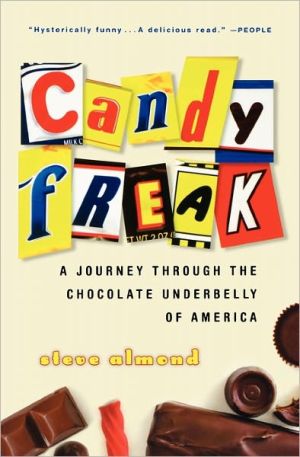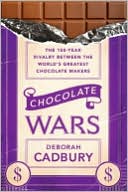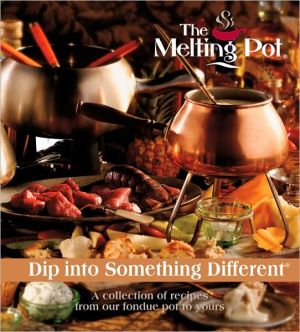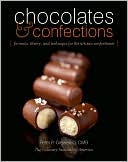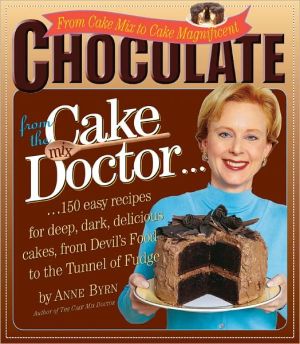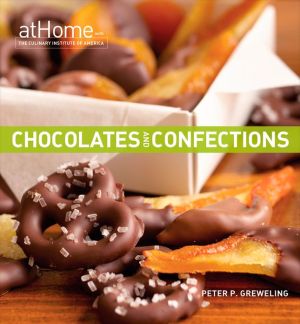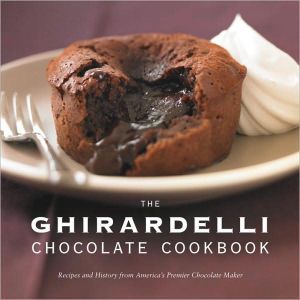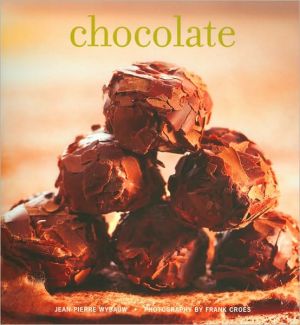Candyfreak: A Journey through the Chocolate Underbelly of America
A self-professed candyfreak, Steve Almond set out in search of a much-loved candy from his childhood and found himself on a tour of the small candy companies that are persevering in a marketplace where big corporations dominate.\ From the Twin Bing to the Idaho Spud, the Valomilk to the Abba-Zaba, and discontinued bars such as the Caravelle, Marathon, and Choco-Lite, Almond uncovers a trove of singular candy bars made by unsung heroes working in old-fashioned factories to produce something...
Search in google:
Driven by his obsession, stubborn idealism, and the promise of free candy, self-confessed candyfreak Steve Almond takes off on a quest to discover candy's origins in America, to explore the little companies that continue to get by on pluck and perseverance, and to witness the glorious excess of candy manufacturing.From the Twin Bing to the Idaho Spud, the Valomilk to the Abba-Zaba, Almond uncovers a small legion of singular handcrafted candy bars made by unsung heroes, working in old-fashioned factories for tiny profits to produce something that they love. Fascinated by the emotional power of these confectionary delights, the primal and persuasive experience of the world in our mouths, Almond describes our candy cravings in sensuous and titillating detail. Though the road is laden with free samples, he discovers that the world of candy making is not the sweet world of childhood reveries but one beleaguered by stiff competition, closely guarded secrets, and increasingly limited markets. But no matter. As he also finds, every candy maker, even when poised on the edge of failure, is happy, indulgent, and childlike. For finally, even the darkest market forces, even the clout of the Big Three candy companies that threaten to wipe out all others, cannot lessen our desire to lose ourselves in chocolate.Candyfreak is the bittersweet story of how Steve Almond grew up on candy--and how, for better and worse, candy has grown up, too. Almond gives us a hilarious, sugar-high tour of those old-fashioned candy companies. The New York Times - Kate Ja.cobs …p; for the most part, Almond goes at the subject as if he were a giddy 5-year-old, creating an entertaining book full of repeatable tidbits about the candy industry.
The author will now rationalize\ The answer is that we don't choose our freaks, they choose us.\ I don't mean this as some kind of hippy dippy aphorism about the power of fate. We may not understand why we freak on a particular food or band or sports team. We may have no conscious control over our allegiances. But they arise from our most sacred fears and desires and, as such, they represent the truest expression of our selves.\ In my case, I should start with my father, as all sons must, particularly those, like me, who grew up in a state of semithwarted worship.\ Richard Almond: eldest son to the sensationally famous political scientist Gabriel Almond, husband to the lovely and formidable Mother Unit (Barbara), father to three sons, esteemed psychiatrist, author, singer, handsome, brilliant, yes, check, check, check, expert maker of candles and jam, weekend gardener, by all measures (other than his own) a stark, raving success. This was my dad on paper. In real life, he was much harder to figure out, because he didn't express his feelings very much, because he had come from a family in which emotional candor was frowned upon. So I took my clues where I could find them. And the most striking one I found was that he had an uncharacteristic weakness for sweets, that he was, in his own still-waters-run-deep kind of way, a candyfreak.\ I loved that I would find my dad, on certain Saturday afternoons, during the single hour each week that his presence wasn't required elsewhere, making fudge in the scary black cast-iron skillet kept under the stove. I loved how he used a toothpick to test the consistency of the fudge and then gave the toothpick to me. I loved the fudge itself-dense, sugary, with a magical capacity to dissolve on the tongue.\ Following his lead, I even made a couple of efforts to cook up my own candy. I would cite the Cherry Lollipop Debacle of 1976 as the most memorable, in that I came quite close to creating actual lollipops, if you somewhat broaden your conception of lollipops to include little red globs of corn syrup that stick to the freezer compartment in such a manner as to cause the Mother Unit to weep.\ I loved that my dad was himself obsessed with marzipan (though I did not love marzipan). I loved his halvah habit (though I did not love halvah). I loved that he bought chocolate-covered graham crackers when he went shopping, and I do not mean the tragic Keebler variety, which are coated in a waxy, synthetic-chocolate coating that exudes a soapy aftertaste. I mean the original, old-school brand, covered in dark chocolate and filled not with an actual graham cracker, but with a lighter, crispier biscuit distinguished by its wheaty musk. I loved that my father would, after certain meals-say, those meals in which none of his sons threatened to kill another-give me a couple of bucks and send me to the Old Barrel to buy everyone a candy bar. What a sense of economic responsibility! Of filial devotion! I loved that my father chose Junior Mints and I loved how he ate them, slipping the box into his shirt pocket and fishing them out, one by one, with the crook of his index finger. I loved watching him eat these, patiently, with moist clicks of the tongue. I loved his mouth, the full, pillowy lips, the rakishly crooked teeth-the mouth of a closet sensualist.\ It is worth noting the one story about my father's childhood that I remember most vividly, which is that his father used to send him out on Sunday mornings with six cents to get the New York Times, and that, on certain days, if he were feeling sufficient bravado, he would lose a penny down the sewer and buy a nickel pack of Necco wafers instead. This tale astounded me. Not only did it reveal my father as capable of subterfuge, but it suggested candy as his instrument of empowerment. (In later years, as shall be revealed, I myself became a prodigious shoplifter, though I tend to doubt that the legal authorities would deem the above facts exculpatory.)\ The bottom line here is that candy was, for my father and then for me, one of the few permissible forms of self-love in a household that specialized in self-loathing. It would not be overstating the case to suggest that we both used candy as a kind of antidepressant.\ There were other factors in play:\ Oral Fixation-It is certainly possible that there is a person out there more orally fixated than me. I would not, however, want to meet him or her. We begin with thumbsucking. Oh yes. Devout thumbsucker, years zero to ten. I don't remember how I was weaned from this habit, though it was probably around the time my older brother, Dave, asked me if I wanted to feel something "really cool," then told me to put my hands behind my back and rubbed my thumbs with what felt like an oily towelette but was, in fact, a hot chili plucked from the ristra hanging in our kitchen, which I discovered immediately upon sticking my thumb in my mouth. I was rendered speechless for the next four hours.\ So I kicked the thumb but took up lollipops, gum, Lick-A-Stix, hard candies, and Fruit Rolls, which I used to wrap around my fingers and suck until my knuckles turned pruney. I still bite my nails to the quick. I've chewed through a forest of toothpicks. I've even tried to take up smoking. I frequently feel the desire to bite attractive women, not just in moments of amour, but in elevators, restaurants, subways.\ I don't think of this as particularly strange. Babies, after all, learn to interact with the world through their mouths. For a good year or so-before their parents start hollering at them not to put things in their mouths-all they do is put things in their mouths. Perhaps my folks failed to yell this at me enough, because I still take on the world mouth-first, and I think about the experience of the world in my mouth all the time. (I am certain, by the way, that there is some really cool German word for this idea of the world in my mouth, something along the lines of zietschaungundermoutton, and if this were the sort of book that required actual research, I would consult my father, who speaks German.) What I mean by this is that I imagine what it would be like to lick or chew or suck a great deal of stuff. Examples would include the skin of a killer whale, any kind of bright acrylic paint, and Cameron Diaz's eyeballs.\ I practice a good deal of mouthplay.\ If, for instance, I happened to be eating a Jolly Rancher Cherry Stick, which I happened to be doing for much of my youth, I would gradually shape the candy into a quasi retainer. This was done by warming the piece until malleable, then pressing it up into my palate with my tongue. At a certain point, this habit morphed into an ardent belief that I could use candy to straighten my teeth, which were (and are) crooked. This was not such a crazy idea. Braces, after all, operated on the basic principle that if pushed hard enough, teeth would move. So I spent most of fifth and sixth grades with a variety of hard candies lodged between my upper teeth. Charm's Blow Pops were most effective for this purpose, because they had a stick and could thus be removed voluntarily.\ The Whole Name Thing-You will have noticed by this time, that I have a distinctly candyfreakish name. This is not my fault. All credit or blame should be directed to my paternal great-grandfather, the Rabbi David Pruzhinski (blessed be his memory), who came from the region of Pruzhini to London around 1885 and changed his name to Almond. Why Almond? The official explanation is steeped in academic ambition. David took secular classes during the day then raced off to attend rabbinical classes at night. The professors at his college posted grades and assignments in alphabetical order. So he needed a new name that began with a letter at the beginning of the alphabet. No one knows why he settled on Almond over, say, Adams. There has been speculation that he was the victim of a prank. Or that he chose Almond because the almond tree is frequently mentioned in the Old Testament. Whatever the reason, I was saddled with this strange name, which meant that I was constantly, constantly, being serenaded with the sometimes you feel like a nut Almond Joy/Mounds jingle, which I would have liked to quote in full, except that Hershey's legal staff denied me permission. I can certainly understand why. God only knows what ruin might befall Hershey if this jingle-which hasn't been used in two decades-were suddenly brazenly resurrected by a young Jewish candyfreak. One shudders to consider the fallout for the entire fragile candy-jingle-trademark ecosystem. The company was, however, thoughtful enough to include in its letter of refusal a coupon for a dollar off any Hershey product-Twizzlers included!-which certainly went a long way toward restoring my faith in corporate America.\ I should note that the success of this particular jingle was an undying source of fascination to me and especially irksome because I didn't even like almonds as a kid and absolutely loathed coconut, an enmity which will be discussed further on. I'm not suggesting that my identity was determined by something as random as my last name, just as I wouldn't suggest that those with the last name Miller will grow up with a predilection for cheap beer. But there is no doubt that having a name associated with candy was a contributing factor. So was the date of my birth, October 27, a mere four days before the Freak National Holiday. And one other fact that I have come to regard as eerie: for virtually my entire childhood our family lived on a street called Wilkie Way.\ Freak Physiology-I have been endowed with one of those disgusting metabolisms that allow me to eat at will. To physiologists, I am a classic ectomorph, though my ex-girlfriends have tended to gravitate toward the term scrawny. The downside of this metabolic arrangement is that I am a slave to my blood sugar. If I don't eat for too long, I start thinking about murdering people, and I am inexorably drawn toward fats and carbs. I hate most vegetables, particularly what I call the evil brain trio-broccoli, cauliflower, brussels sprouts, which taste, to me, like flatulence that has been allowed to blossom. Left to my own devices, my diet would consist of dark chocolate and baguettes, with perhaps a grilled pork rib thrown in for variety. I realize that I am going to hell.\ Every now and again, I'll run into someone who claims not to like chocolate or other sweets, and while we live in a country where everyone has the right to eat what they want, I want to say for the record that I don't trust these people, that I think something is wrong with them, and that they're probably-this must be said-total duds in bed.\ © 2004 by Steve Almond All rights reserved. No part of this publication may be reproduced or transmitted in any form or by any means, electronic or mechanical, including photocopy, recording, or any information storage and retrieval system, without permission in writing from the publisher.\ Requests for permission to make copies of any part of the work should be mailed to the following address:\ Permissions Department, Harcourt, Inc.,\ 6277 Sea Harbor Drive, Orlando, Florida 32887-6777.
Prologue : some things you should know about the author1The author will now rationalize9Chocolate = enabler17In which an unhealthy pattern of dependence is established18An ill-advised discussion of freak economics24Night of the living freak30Mistakes were made33Caravelle : an elegy38I [love] Manny48Feeding the beast54A top-secret chocolate situation61The politics of the rack66The last man in America with Black Jack gum72The Capo Di Tutti freak81The love song of Ray Luthar Broekel86Welcome to the boom92There are men upon this earth who tread like gods100Feuilletine, revealed107Freak fetish115The official dark horse freak of Philadelphia118Wee Willie and the Pop-a-Licks rage125Southern-fried freak133Chocolate haiku140Freak retentive149In the belly of the freak152The unstoppable freak energy of Mr. Marty Palmer155Southbound with the hammers down173The candy bar on your chin178The marshmallow parallax188A depressing but necessary digression199Boise : gateway to... Boise201Ladies and gentlemen, the Idaho Spud205Huckleberry, hounded216American lunch224How will the Spud survive?228The past is just ahead234Remember this name : Banana-Zaba241A second depressing but necessary digression248A little hidden bomb in my Idaho Spud250A few final relevant facts254Acknowledgments263Freak appendix265
\ From Barnes & NobleBarnes & Noble Discover Great New Writers\ Who remembers their favorite candy from childhood? Does it still exist? Or do you glance down at the glistening wrappers in the candy aisle, wistful for a time -- and a bar -- gone by? Take comfort; you're not alone. For Steve Almond is obsessed with candy, too, allowing himself a daily ration to keep his consumption within bounds. During his "infamous campaign of 1973," he experienced a "run of seven cavities," which required the regular numbing of his jaw to fill. And he keeps an ever-ready stash of several pounds of the sweet stuff, stockpiling boxes of certain favorites against a feared drought. \ Almond's obsession sends him on a cross-country quest to rediscover the candy bars of his youth, notably the vanished Caravelle (not to be confused with the 100 Grand (a bar of similar ingredients but wholly inferior quality), Almond's personal Holy Grail. But along the candy trail, our sleuth also discovered a number of quirky small-production bars, too. Almond extols the virtues of these small producers, companies that continue to roll out their treats despite pressure from the big candy conglomerates that gobbled up and discontinued many of the bars of our candy-filled childhood. Almond's unbridled enthusiasm for confectionery delights is both hilarious and infectious, a tribute to a substance that evokes fond memories for readers of every ilk. (Summer 2004 Selection)\ \ \ \ \ \ Kate Ja.cobs…p; for the most part, Almond goes at the subject as if he were a giddy 5-year-old, creating an entertaining book full of repeatable tidbits about the candy industry. \ — The New York Times\ \ \ Publishers WeeklyThe appropriately named Almond goes beyond candy obsession to enter the realm of "freakdom." Right up front, he divulges that he has eaten a piece of candy "every single day of his entire life," "thinks about candy at least once an hour" and "has between three and seven pounds of candy in his house at all times." Indeed, Almond's fascination is no mere hobby-it's taken over his life. And what's a Boston College creative writing teacher to do when he can't get M&Ms, Clark Bars and Bottle Caps off his mind? Write a book on candy, of course. Almond's tribute falls somewhere between Hilary Liftin's decidedly personal Candy and Me and Tim Richardson's almost scholarly Sweets: A History of Candy. There are enough anecdotes from Almond's lifelong fixation that readers will feel as if they know him (about halfway through the book, when Almond is visiting a factory and a marketing director offers him a taste of a coconut treat, readers will know why he tells her, "I'm really kind of full"-he hates coconut). But there are also enough facts to draw readers' attention away from the unnaturally fanatical Almond and onto the subject at hand. Almond isn't interested in "The Big Three" (Nestle, Hershey's and Mars). Instead, he checks out "the little guys," visiting the roasters at Goldenberg's Peanut Chews headquarters and hanging out with a "chocolate engineer" at a gourmet chocolate lab in Vermont. Almond's awareness of how strange he is-the man actually buys "seconds" of certain candies and refers to the popular chocolate mint parfait as "the Andes oeuvre"-is strangely endearing. (Apr. 9) Copyright 2004 Reed Business Information.\ \ \ \ \ VOYAAlmond is obsessed with candy. He claims that not one day of his life has passed when he has not had a candy bar. He takes his obsession on the road and details for readers his travels to small candy factories around the country, encouraging others to engage in his candy feast. He visits the home of the Idaho Spud, the Goo Goo Cluster, Valomilk, and the five Star Bars. On his way, he entertains readers with candy trivia and his longing for Caravelle candy bars. Peeps, Chuckles, Jordan Almonds, and Circus Peanuts are included in his list of MWMs (mistakes were made), products that never should have been candies in the first place. Almond's sense of humor and his encyclopedic knowledge of candy makes this book an enjoyable trip across the chocolate-covered countryside. He is fanatical in his interest, and he quickly pulls readers into his obsession, making a trip to the candy counter a necessary result of reading. Young adults will feel his passion and most likely will begin searching for the elusive Violet Crumble and Twin Bings. Although not for everyone, this book will touch teens who appreciate the eccentric, and they will love Almond and his candy crusade. VOYA Codes 4Q 2P S A/YA (Better than most, marred only by occasional lapses; For the YA with a special interest in the subject; Senior High, defined as grades 10 to 12; Adult-marketed book recommended for Young Adults). 2004, Algonquin, 280p., Ages 15 to Adult. \ —Lynn Evarts\ \ \ \ \ Library JournalA former journalist, Almond (creative writing, Boston Coll.; My Life in Heavy Metal) is obsessed with candy; it shaped his childhood and continues to define his life in ways large and small. Fascinated by the emotional bonds that people develop with their childhood favorites, Almond began a journey into the history of candy in America and discovered a lot about himself in the process. Once hundreds of American confectioners delivered regional favorites to consumers, but now the big three of candy-Hershey, Mars, and Nestl -control the market. To find out what happened to those candies of yesteryear, Almond talks to candy collectors and historians and visits a few of the remaining independent candy companies, where he learns exactly what goes into creating lesser-known treats such as the Idaho Spud. Flavored with the author's amusingly tart sense of humor, Candyfreak is an intriguing chronicle of the passions that candy inspires and the pleasures it offers. Recommended for most public libraries as a nice counterpart to Tim Richardson's more internationally focused Sweets: A History of Candy.-John Charles, Scottsdale P.L., AZ Copyright 2004 Reed Business Information.\ \ \ \ \ Kirkus ReviewsAlmond, a self-diagnosed "candyfreak," details with mouthwatering descriptions his visits to the minor league of candy makers who continue to churn out their distinctive products. Claiming to have eaten at least a piece of candy every day of his life, Almond first establishes his candy credentials. He always has at least three to seven pounds of candy in his home; he's stashed 14 boxes of Kit Kat Limited Edition Dark in a warehouse; he has further supplies in drawers in case of an emergency; and at Halloween his haul was between 10 and 15 pounds. But mourning the disappearance of so many independent candy makers-a street in Cambridge, Massachusetts, was once known as Confectioner's Row-and his own favorite bar, the Caravelle, he decides to find out what happened, and what makers still remain. The search, serendipitously fueled by boxes of free samples, leads him to factories in such places as Dorchester, Massachusetts (Necco wafers and candy hearts); Burlington, Vermont (the Five Star Bar); and Sioux City, Iowa, where he watches The Bing, a regional favorite, being made. At each factory he witnesses every step of the process, and always gets to sample the product. He also meets Steve Traino, a fellow candyfreak who has tapped into the nostalgia candy market by buying and then selling discontinued items online, and Ray Broekel, the industry's historian, who has a vast collection of candy memorabilia, from wrappers to advertising. Almond is impressed with these independent manufacturers, always generous and dedicated, but also realistic about their limitations, both in distribution and longevity. All are up against the Big Three-Mars, Hershey, and Nestle-who have the money and the muscle tokeep the little guys out of the big stores, as well as to steal their ideas: facts that inevitably sour this otherwise delicious celebration of all things sweet. Sweet, never sickly-and quite informative.\ \
